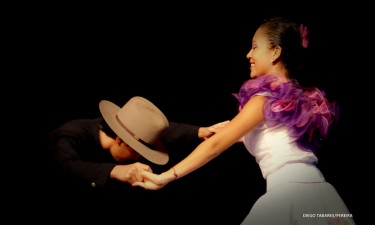This post is part two of a series on the Venezuelan plains and its culture. Follow this link to read the first post of the series.
Of the musical genres that constitute the folklore of the plains of Venezuela, the joropo has long been the most characteristic of this part of the country. This type of music and dance comes from the broad flat areas of Venezuela, where the prevalent culture is closely related to the land and livestock. Its music is heard up to the north coast and traditions are shared both in the plains of Venezuela and Colombia. In summary, the joropo represents the mixture of cultures that have evolved at their own pace and that characterize much of Venezuelan culture, which continues to evolve and mix today.
The history of this musical genre in Colombia is told in the Que viva el joropo [es] (“Long Live Joropo”) blog:
Es el baile folklórico más representativo de los Llanos colombo-venezolanos; es una de las danzas folklóricas que presenta la típica supervivencia española, engendrada en los bailes flamencos y andaluces, como así lo demuestran sus zapateos. La palabra “joropo” viene del arábigo “xarop” que significa “jarabe” y está emparentado con los jarabes tapatíos de México. En esta danza las parejas bailan zapateado y sueltas; el cuerpo permanece más bien quieto, dando mucha importancia al taconeo, el cual es rápido. En danza de coqueteo, el llanero trata de conquistar a la mujer, gira trazando un espiral y da vueltas progresivamente más apretadas y juntas en persecución del centro que ocupa la mujer, quien remisa y recatada se aproxima al varón.
The structure of the joropo can be heard and watched through the YouTube channel “Armonías de Venezuela” (“Venezuelan Harmonies”). In this video the group dedicates an instrumental joropo titled “Pasajes Venezolanos” to the composer Pablo Camacaro.
Thanks to artists and lovers of the culture of the plains, many samples of this music and dance can be found on citizen media like YouTube. In this video the group Caribabare de Villanueva Casanare shows the performance of its instruments and its dance couple.
In a similar way, in the blog Folklore Venezolano, Joropo Llanero [es] one can find several examples of this music and of the stories that characterize the region.
Also Oscar J. Camero's blog, Llaneras [es], shares and discusses the origins and characteristics of the music of the plains. Camero mentions authors and musicians dedicated to the preservation and expansion of the music of the plains, and also discusses its constant evolution:
Dice textualmente Claudia Calderón Sáez, en su “Sobre la dialéctica entre el golpe corrido y el golpe de seis[…] Tipología rítmica, armónica y estructural de los golpes llaneros”, que “El Joropo es una expresión de arte popular en permanente evolución, que involucra poesía, canto, música y danza en una forma de creatividad improvisatoria sobre estructuras establecidas y parámetros determinantes de estilo”, haciendo hincapié en que es una manifestación cultural originada fundamentalmente en el perímetro de la “cuenca central del Orinoco”, desde Villavicencio, en Colombia, hasta los estados Apure, Guárico, Cojedes y Portuguesa, en Venezuela. Se instrumenta básicamente con el arpa (o bandola), cuatro y maracas.
Within this evolution, there have been several musicians who have taken the strong rhythms of joropo to instruments used in academic music. An example of this can be seen in this video, in which Silvia Navarrete plays a joropo composed by Moisés Moleiro for the piano in the mid-twentieth century:
Finally, the following video of Dudamel and the Youth Symphony Orchestra during their participation in the BBC Proms, shows another mutation of the joropo. This video has been widely shared and discussed among citizen media inside and outside Venezuela:







